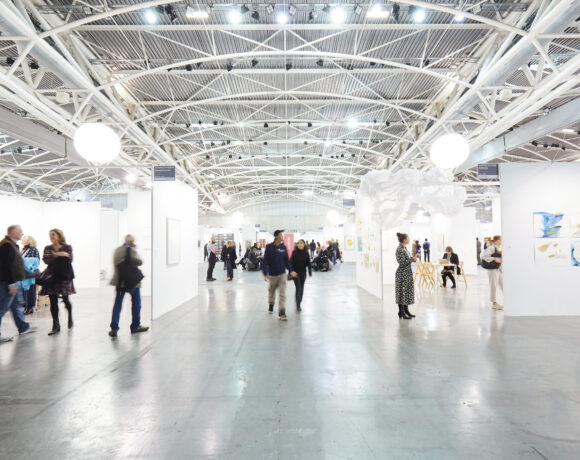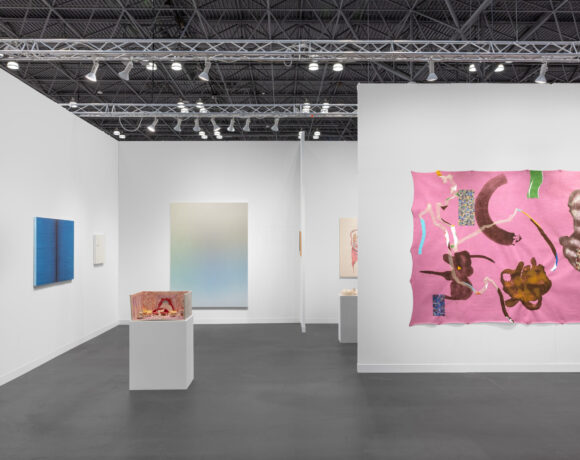This year’s Artissima marks its 31st anniversary. While the fair has grown in popularity and price, it continues to be a place for finding the touchingly creative, the odd and occasionally sardonic works. Artissima is arguably a place to catch up with the latest happenings in the art world. It’s where masses of art lovers gather under one roof with exhibitors, curators, artists and collectors to come face to face with artworks across all sectors and all levels of the market. Many reports spotlight the fair’s ‘noteworthy’ aspects, such as sales performance, attendance numbers, sponsorship initiatives and the elaborate design of Artissima’s programs, all of which showed impressive outputs. However, there was more to be seen between the lines that separated art booths.

Artissima 2024 © Perottino-Piva-Castellano-Peirone
For many, the fair is also a marketplace where transactions reflect a downturn in the market. What strikes others, however, is the eye-opening shifts in the global art market and how it translates into an array of the most exciting contemporary works being created. Economic considerations, cultural aspects or simply matters of logistics have pushed global galleries to increasingly experiment with presenting their work in Europe. This echoes a cautious optimism that’s fueled by a synergy between emerging artists and international galleries and collectors. Among Artissima’s about 200 exhibitors was a new wave of young galleries, with many curating their programs with an international perspective. The fair was an exploration of both Western and non-Western identities from North America, Latin America, Asia, and Africa, catering to different regions and tastes. Below, a brief review of the booths and proposals that we consider most interesting.

Artissima 2024: Alma Pearl gallery (Regno Unito)
Celeste Baracchi opened her gallery, Alma Pearl, in 2023, aiming to reposition itself as a conduit for community building at a global level. At Artissima, the gallery exhibited “Eyes”, an installation by Cullinan Richards, transforming the art fair booth into a liminal space that blurs the boundaries between the observed and the observer. On another wall, the “Pencil Factory” painting by Moscow-born Margarita Gluzberg added a sentimental touch to the booth. It uses the entire set of colored pencils produced by Krasin, a Soviet factory that no longer exists. Through this abstract visual lexicon, the artist «formalizes a reality that is now gone!» Baracchi remarked. Jhonatan Pulido’s series covered another facet of the booth, portraying works inspired by the aftermath of the Colombian civil war. His work was listed among the best shows during Frieze Week 2023. The impressive reception of the artist at Artissima could be translated as an outpost of human experience.

Artissima 2024: First Floor Art Gallery Harare (Zimbabwe)
Valerie Kabov, who directs First Floor Art Gallery Harare, was at the fair with the works of Anne Zanele Mutema, a Zimbabwean artist who experiments with ideas of space and false memories in a unique installation. Pebofatso Mokoena‘s paintings, evolving around micro and macro scales of politics, architecture and the environment, covered the next wall of the booth. «South Africa has a very dynamic art scene as well as Zimbabwe» Kabov said. «Being an emerging artist is always difficult, but there are a lot of interesting things happening at the moment». With the great reception of this African artist’s works, we can expect the gallery at future fairs held here in Europe.

Artissima 2024: Galerie Steinek (Austria)
In the main section, Steinek Gallery‘s booth presented paintings by Soli Kiani. This Iran-born artist conveys an outspoken social commentary through remarkable compositions that explore concepts of freedom. Next to it there were austere wall works by pioneering Constructivist artist Clemens Wolf. Both artists examine the essence of freedom, using direct symbolism as well as contemporary abstraction. The booth’s theme ushers a desire to discover different cultural perspectives through a conceptual parallel. «There’s a powerful history of these artists with our gallery, with this being the third time that we’ve exhibited their works together» Steinek said. «Despite their differences, their work focuses on the same context».

Artissima 2024: La Cometa (Colombia)
Further apart, La Cometa Gallery exposed the ideology and generalized norms and peeks at a persecuted community through the lenses of Miguel Angel Roja. «Miguel Angel started to document the queer scene in Colombia over three decades» said Jaramillo. «He looked into a lot, from documenting secret gay encounters in Bogotá’s movie theaters back in the ’70s to examining the ties between the criminal drug market, the high society and eradicating some of the Indigenous traditions. Miguel Angel Rojas has really been a key influence in contemporary art throughout Colombia and Latin America and continues to be since some of the topics he touched on are to this day fairly relevant social issues».

Artissima 2024: Rolando Anselmi Galerie (Berlino, Roma)
Returning curated section this year included the Rolando Anselmi Gallery exhibition, with a collective section flanked by a solo exhibition of Vincenzo Schillaci’s works. Schillaci is known for two things: abstract compositions and the use of ancient techniques. His works question the current codes of representation of body and identity while his technique revisits the materials, such as marble dust and quartz powder, which were used by the old masters. It was a delight to witness how Schillaci was celebrated for his remarkable paintings. Adjacent to the solo exhibition, the booth presented late-career artists, including Ulrich Erben, alongside lesser-known artists. «Adéla Janksà was the first person to join our recent residency program» Caterina Della Longa said. She’s a Czech artist whose work has been displayed in the United States, but she is making her debut here in Italy».

Artissima 2024: Lohaus Sominsky Gallery (Germania)
Themes of time and its perception were diversified together at Lohaus Sominsky‘s booth. The gallery convened a diverse array of both new and established artists. Ilit Azoulay‘s works examine ‘time’ with a macro-lens using a symbology that’s meaningful to the modern while emitting her cultural background as an Israeli artist of Moroccan origin. The opposite wall was lined with a nostalgic display of “Tableaux”, Staack Juergen‘s age-old glass negatives turned into wistful positive photographs that were exposed to sunlight over a whole year. There’s nothing quite like nature when it comes to portraying time and its passage. Jetelová Magdalena‘s works are characterized by rich yet raw interpretations of the natural world, including the Pacific Ring of Fire, showcasing the underwater mountain range and the course of the continental watershed.

Artissima 2024: Amanita Gallery (USA)
Italy has a rich history of art, as well as world-renowned contemporary artists. Today, its art scene is marked by international collaboration, with a huge density of galleries, as well as longstanding art associations. Amanita Gallery was founded in 2021 with the aim of fostering a cross-cultural exchange for emerging artists in the U.S. and abroad. «We are mostly present in New York now, so it’s nice to create a new following for our artists here in Italy» marked Thea Mousa. «We had an exhibition space in Florence for a year and a half, and hopefully next year, we’ll be putting a gallery in Rome as well as a second space in New York». Italian community is close-knit, with collectors and institutions typically focused on collaborative growth. Amanita presented the artworks of three artists at the main section of the fair. The trio of works combines unique techniques, such as Francesco Cima‘s “Dark Souls on Velvet”, among others.

Artissima 2024: Acappella Gallery (Napoli)
For this year’s fair, Acappella changed its approach to accommodate a broader, more comprehensive presentation. «We usually use Artissima as an opportunity to debut young artists. But not this time. We decided to create a more democratic presentation to showcase not only a solo artist but the best of works that we have found as the result of the research we have done over the past ten years» said Corrado Folinea. The wider developments that have taken place in recent years are surely a motive to create dialogues between young artists and the international art world.

Artissima 2024: A+B Gallery (Brescia)
From a wall presenting Nazzarena Poli Maramotti‘s romantic sky to the jagged sculptural works of Gleißende Welt at the booth’s entrance, A+B Gallery was as dynamic as it was varied. The presentation focused on works with a global art world profile. There was «a great reception for the presented artworks, with people interested and asking the right questions» said Dario Bonetta.

Artissima 2024: Foco Gallery (Portogallo)
Dyed or bleached fabrics come together to create gestural paintings in Manuel Tainha‘s dreamlike artworks. His work, which uses unexpected techniques and materials, evokes the cosmos and a sense of mystery. Foco Gallery’s booth displays a solo exhibition from the artist. «The references to his background in architecture and how, in a way, he explores compositions» said Benjamin Gonthier. These cultural values of how the artist handles materials and limitations follow raw and organic impulses. These elements are constants in this Portuguese artist’s works that, while being compositionally pleasing, build a visual bridge that communicates ideas from the artist to the public.

Artissima 2024 © Perottino-Piva-Castellano-Peirone
Artissima strikes an interesting balance between price points and the range of galleries across the fair. It captures a broad spectrum of values presented from the new to the most established names, which also fosters creative dialogues. And the fair has contributed much to this through its uncompromising standards for arts, stringent cultural appetite and a positive curiosity toward the art scenes across the globe.
Elena Mazaheri
Info:

is a contemporary art magazine since 1980






NO COMMENT